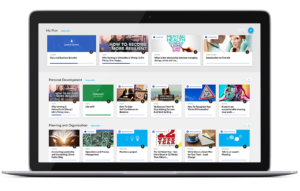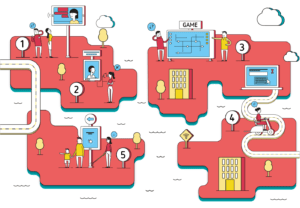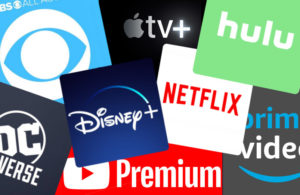 What comes to mind when you hear the name “Netflix“? Orange Is The New Black… the Wonder Years… your favorite casual pair of nighttime sweatpants…?
What comes to mind when you hear the name “Netflix“? Orange Is The New Black… the Wonder Years… your favorite casual pair of nighttime sweatpants…?
While we love binge-watching our favorite TV shows as much as the next guy, we associate Netflix with something else: crazy-good content that accelerates your entertainment like gangbusters when you start streaming.
Netflix’s core belief is that customization wins customer loyalty, a belief that puts data at the center of its corporate strategy. Netflix invested heavily in data mining technologies to develop a content recommendation algorithm, leading the way in using data to provide a GREAT customer experience.
And it worked!
Recommendations drove 50% of their traffic. After adopting a streaming model, this data-first approach continued, and it’s made them one of the top streaming video-on-demand services available.
Today, it’s giving them the customer insight they need to create MASSIVELY successful original content and Netflix’s data (click here) gives them the insight to develop content. None of this would have been possible without collecting all of the user data that they had available to “feed” their algorithm.
Green CulturED eLearning Solutions
We’re no strangers to data either. We’ll get into more detail later, but here at Green CulturED, we rely on data to help us make training decisions that are all but guaranteed to work. Our belief?
Gut instincts may be good, but data never lies. The challenge, of course, is in your training methods. How do you go from data to STRATEGIC training decisions that grow your cannabis business?
Let’s take a look…
Well-Executed eLearning Strategy Method
To master cannabis training and the industry, you need to master three (3) guiding principles:
- Give Training a Job: This is the foundation of training analysis, every piece of knowledge you gather should help you answer questions and make smart cannabis training decisions.
- Use Hypothesis Testing to Convert Questions into Strategies: This is what makes training meaningful, it’s the process of transforming raw ideas into cannabis training decisions.
- Apply Context to Account for the Unmeasurable. Some things are very hard to measure, for those situations, you need to contextualize the cannabis industry training.
Analytics and data shouldn’t be stressful. But it’s EASY to feel that way when there are so many training sources to draw from, each formatting their cannabis education or platform competencies differently, sometimes even giving different values for the same online training metric.
Where do you put your attention? How do you compare training from different sources?
Are LXPs the “Netflix of Cannabis Training”?
 As buzzwords go, who wouldn’t want to be thought of as offering the “Netflix of Cannabis Training“? It’s a BOLD statement that promises unprecedented levels of content, engagement, and digital innovation. It conjures images of users spending hours binge-watching viral content.
As buzzwords go, who wouldn’t want to be thought of as offering the “Netflix of Cannabis Training“? It’s a BOLD statement that promises unprecedented levels of content, engagement, and digital innovation. It conjures images of users spending hours binge-watching viral content.
The Learning Experience Platform (LXP) is the newest term on the long need-to-know list of acronyms all self-respecting eLearning professionals keep tucked in their pockets. At first glance, an LXP is probably indistinguishable from a Learning Management System (LMS), at least the basic learning activities and resource features.
After all, the LMS and the new-fangled LXP perform the same basic function: getting your learners access to digital cannabis training. While it has been said that LXPs offer this fabled Netflix-like experience, we think the analogy is flawed. Here’s why. Some of the biggest technology announcements concerning online streaming subscription platforms and new services…
We’ve seen the entry of Apple, AT&T, Disney, and NBCUniversal into the consumer video streaming market. Meanwhile, Google and Microsoft launched major flagship services attempting to claim territory in an emerging streaming space by the growing comfort with the idea of the technology.
There’s a belief that the trend and the greatest potential gains in learning technology involve “learning as you live.” There is value in having the presentation and structure of learning platforms that replicate ideas established by these streaming technologies placed in our everyday lives.
With streaming entertainment platforms such a huge aspect of domestic life, it’s surely inevitable that a learning technology will EMERGE in that familiar shape. As many before us have asked in the cannabis industry, invoking the current category leader, where is “The Netflix of Cannabis Training”?
Visual Learning Playground Fantasy
 The answer has supposedly emerged in the form of the Learning Experience Platform (LXP). This is a diverse and sometimes nebulous category that many platforms in the cannabis industry claim membership in, it’s certainly an appealing answer: people love the Netflix format.
The answer has supposedly emerged in the form of the Learning Experience Platform (LXP). This is a diverse and sometimes nebulous category that many platforms in the cannabis industry claim membership in, it’s certainly an appealing answer: people love the Netflix format.
As learning creators, we would be thrilled to create an environment where cannabis training is so enthusiastically consumed. Or even BINGE-viewed. As a total eLearning solutions provider of the cannabis industry, we understand the appeal of learning in a training format we regularly immerse ourselves in.
However, while there’s certainly a kernel of truth in the idea that the LXP is this sought-after “Netflix of Cannabis Training,” the analogy is ultimately superficial. What people want is a user interface that looks like Netflix, not necessarily everything behind that User-Interface (UI) you interact with.
When people think about Netflix, they inevitably think of the visual nature of the platform. So, modern images designed to catch your attention, that when selected draw you in with motion and trailers. Netflix’s great strength is how it has visually cataloged content in its platform this way.
It’s important to never lose sight of the fact that people go to streaming platforms for entertainment and escapism. Not productivity or learning. It’s where you go to disconnect from the world. This is HARDLY the connotation you want for cannabis training, no matter how “fun” we want it to feel.
Why Netflix = Imperfect LXP Model
 Furthermore, Netflix is a great example of the difficulty of recommending relevant content to users. Even with millions of subscribers worldwide feeding its algorithm (click here), it’s hardly unusual to find yourself scrolling endlessly through Netflix’s recommendations.
Furthermore, Netflix is a great example of the difficulty of recommending relevant content to users. Even with millions of subscribers worldwide feeding its algorithm (click here), it’s hardly unusual to find yourself scrolling endlessly through Netflix’s recommendations.
A good amount of the content that Netflix shows to you simply MISSES the mark. Perhaps you exclude content because the mood simply doesn’t take you at that moment. You’re just as likely to have a deer-in-headlights moment in the face of too much relevant content presented.
Considering that such platforms have a pool of thousands of titles to draw, this experience is arguably part of the design: breadth of content covers the gaps left by the human whims that algorithms struggle with. And when all else fails, at least you’re impressed by just how much it is available.
This maps poorly to cannabis industry learning platforms. Providers aren’t trying to ensure learners continue to pay monthly subscriptions out of FEAR of missing out. Cannabis education providers are also unlikely to have quite so many feature-length assets in their online cannabis training library.
Most organizations want to quickly provide the answers that their employees need, to avoid frustration and obstruction. Netflix also has a recommendation engine essentially disconnected from its inner workings. You’ll watch titles recommended by a friend, or a show currently being enthusiastically discussed by your friends on social or entertainment media announcements.
In contrast to Learning Experience Platforms (LXP’s), Netflix has no built-in social functions. Nothing in the platform is intentionally collaborative. So, if the LXP isn’t the “Netflix of Cannabis Training,” what is? We believe the answer lies in another popular video streaming platform: YouTube.
YouTube Starting Point = Forward-Thinking LXP
 The Learning Experience Platform (LXP) is more analogous to YouTube. Indeed, the main reason that the “YouTube of Cannabis Training” hasn’t caught on as a buzzword, is that YouTube is the YouTube of learning. People ALREADY check YouTube if they want to learn how to do something that they want to learn about cannabis.
The Learning Experience Platform (LXP) is more analogous to YouTube. Indeed, the main reason that the “YouTube of Cannabis Training” hasn’t caught on as a buzzword, is that YouTube is the YouTube of learning. People ALREADY check YouTube if they want to learn how to do something that they want to learn about cannabis.
It’s an invaluable resource for concise, microlearning-style pieces of content that explain how to do something. YouTube is also a haven for user-generated content. Over half – 65% of the top 100 YouTube channels – belong to digital natives rather than other digital content organizations.
User-generated content is an important differentiator for many LXPs when compared to the traditional purely top-down approach of the Learning Management System (LMS). That said, YouTube isn’t a perfect analog for the LXP either. YouTube’s main purpose is still very much entertainment.
However, the behaviors of how-to searchers were a source of inspiration for LXPs. Filters, categories, and engagement metrics are some of the main factors that help to surface the most relevant content. An LXP should be careful to balance engagement against the relevance of cannabis training.
In most of the cannabis industry, compliance training will find itself on the top of any “most-watched” and “longest interaction” lists. A good LXP won’t assign or direct learning as much as it will create an environment to contribute to and enhance content for the SAKE of learning about cannabis.
When learners have the opportunity to comment on, share, like, and follow cannabis industry training, they begin to form learner groups that share similar pieces of cannabis content. This begins to create a community around content and an environment to create more content like it.
Learn From Streaming Platforms
 What then, should you do when stakeholders, cannabis industry Subject Matter Experts (or SMEs), and learners say they want a corporate Netflix? A good question is: What aspects of that Netflix-like experience are you looking for? Is it cannabis training recommendations?
What then, should you do when stakeholders, cannabis industry Subject Matter Experts (or SMEs), and learners say they want a corporate Netflix? A good question is: What aspects of that Netflix-like experience are you looking for? Is it cannabis training recommendations?
Learning Experience Platforms (LXPs) can emulate the look, feel, and function of both. We also need to help them understand that behind this, they will need to be prepared to invest in building a cannabis training structure that FITS the organization. You can build for the learner by making logical categories and flows for them to contribute content to within their cannabis industry training and development.
As important as search is, people also want the ability to browse cannabis training libraries and tags to explore different learning paths offering similar content. Beyond this, LXPs still benefit from having learning paths curated from the top of the organization, though it’s best to take a lighter touch.
Learning and Design (L&D), Human Resources (HR), and cannabis industry compliance can work to make it clear where learners should start their training in the cannabis industry, and where they should go next. We’ve seen significant benefits in making this human element very explicit.
Through features like this, the LXP can shape itself as a technology that isn’t Netflix, YouTube, or any other streaming platform, while nonetheless taking the BEST elements of these platforms and merging them with true productivity and learning tools that are truly needed in the cannabis industry.
Let us know what you think.




Responses